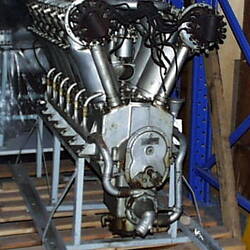The Liberty aero engine was developed in the United States between June and August 1917 as a standard type to be fitted to a variety of military aircraft. A modern high-powered aero engine was vital to the development of US military aviation following the entry of the USA into the First World War in April 1917. It was intended to be manufactured by automotive firms using existing materials and production methods with parts being interchangeable. About 15,500 were manufactured before the armistice.
The official account of the development process relates that the two engineers responsible for the design (J. Vincent and E. J. Hall) were "figuratively locked in a room in a Washington hotel." They had promised to come up with a design before a suitable imported engine could be shipped to the US. A team of draughtsmen produced the drawings and a completed eight-cylinder engine was rushed to Washington for Independence Day, 4 July 1917. By August 1917 the V12 engine, now designated the 'Liberty' had passed its service tests including a fifty hour continuous running trial on 25 August 1917. Hall had been a partner in the Hall-Scott firm and the Liberty design was similar to the Hall-Scott A-8 aero engine. Vincent worked for Packard. The Liberty was intended to be produced in four, six, eight and twelve-cylinder versions.
Around twelve factories produced parts for the Liberty engine. The design had incorporated the most proven materials and design features of several successful foreign aero engines such as the Mercedes, Rolls-Royce and Isotta-Fraschini. Ford and Packard were just two of the US motor industry firms which played a leading part in the standardization of Liberty components for mass-production. Aircraft types fitted with a Liberty engine included the US licence-built DH 4 light bomber, Curtiss H-16 flying boat and the twin engine Glenn Martin MB-1 bomber. Despite the intention to standardize aero engine production, a variety of different engines continued to be made and used in US military aircraft. In the post-war years, Liberty engines were adapted for use in racing cars and marine craft as well as tanks in which capacity it served into the Second World War.
The Liberty was not used in Australia until after 1918 when 29 Airco DH 9A aircraft fitted with Liberty engines were received as part of the British 'Imperial Gift' of aircraft, engines and equipment used to establish the Royal Australian Air Force. These DH9A aircraft were mostly based at Point Cook, Victoria.
More Information
-
Keywords
-
Localities
-
Authors
-
Article types

